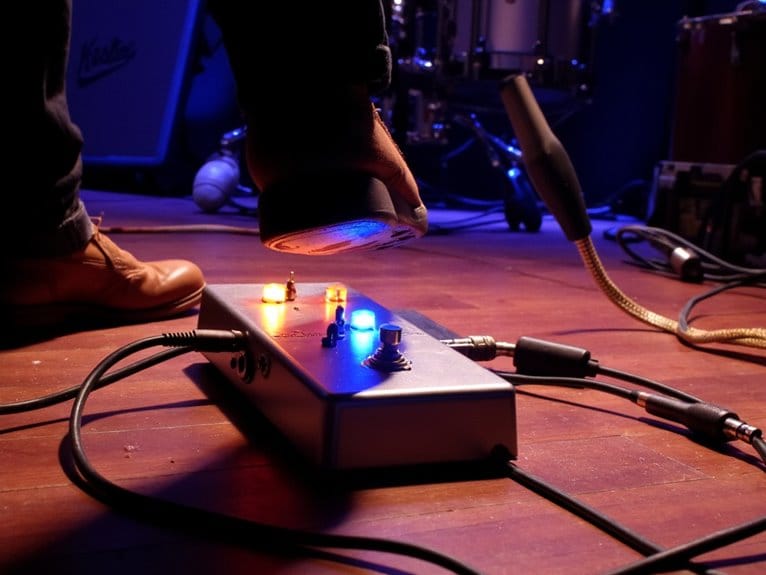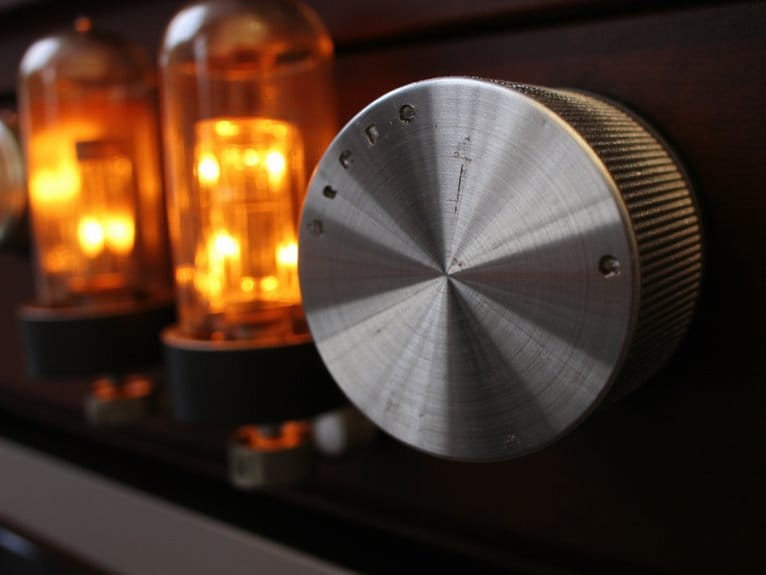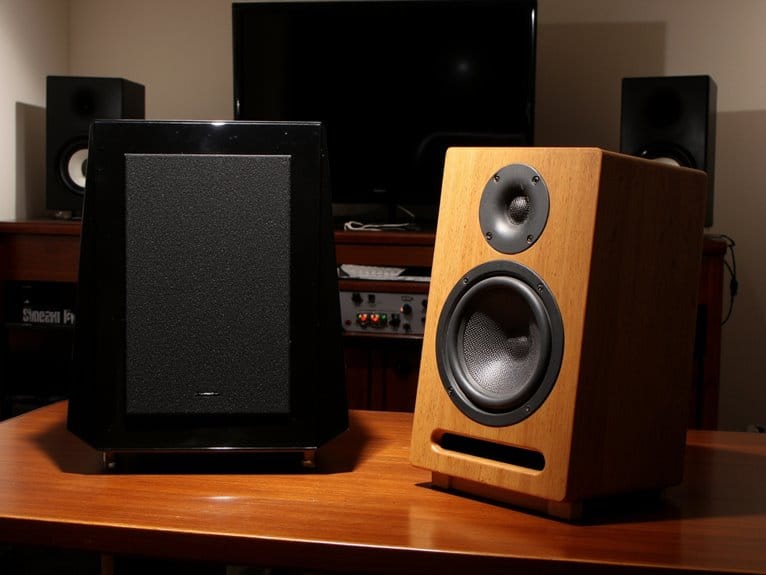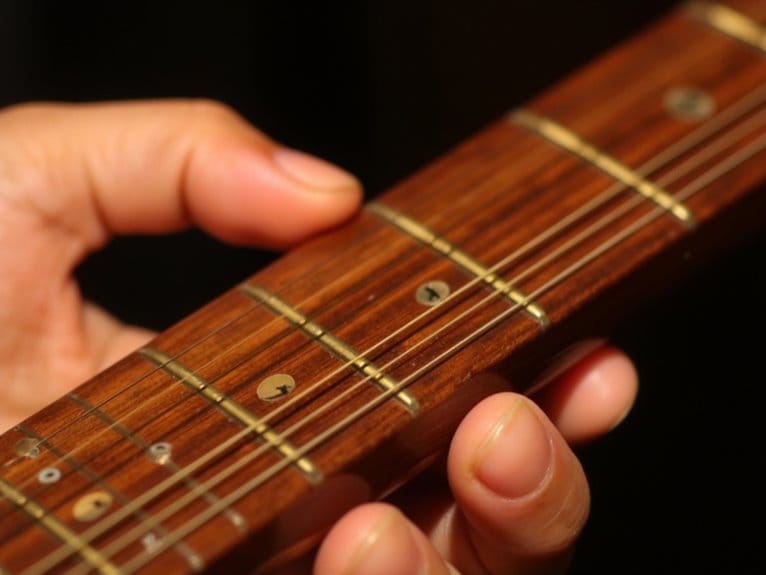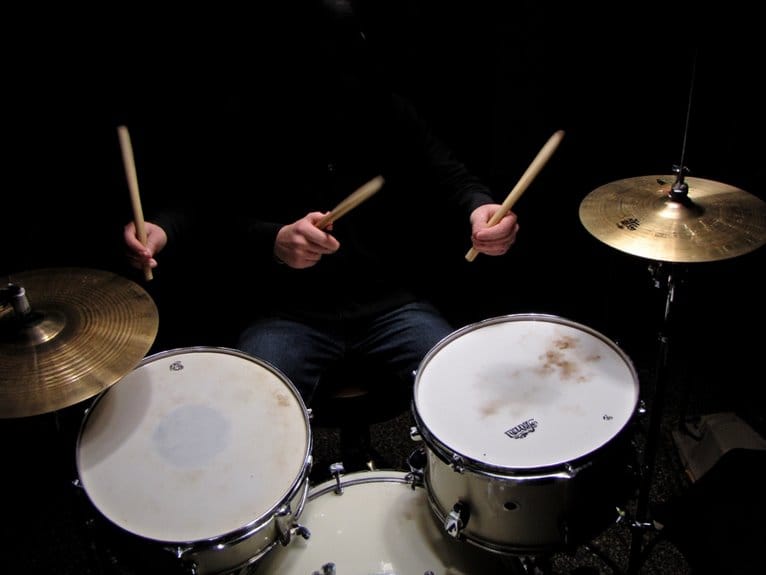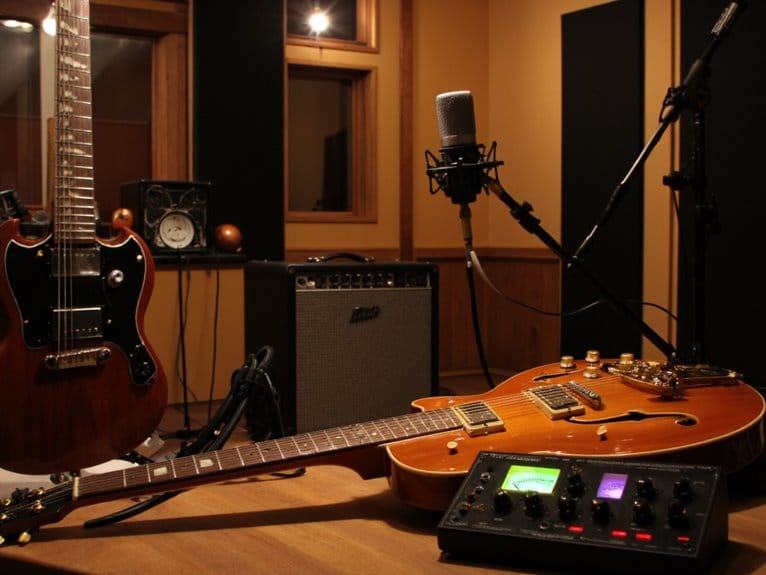Ergonomic Drum Positioning for Comfort and Performance
Your drum throne should position your hips slightly above your knees at a 145-degree leg angle, while keeping your snare drum 1-2 inches above knee level for ideal clearance. Position all drums and cymbals within an 18-24 inch “snow globe” reach zone to minimize shoulder strain, maintain 90-degree elbow angles, and keep your wrists neutral during playing. This ergonomic foundation prevents career-ending injuries while maximizing your performance potential, and there’s much more to assess for a complete setup.
We are supported by our audience. When you purchase through links on our site, we may earn an affiliate commission, at no extra cost for you. Learn more.
Notable Insights
- Position throne height so hipbones sit slightly above knees with 145-degree leg angles to reduce muscle strain.
- Arrange all drums and cymbals within 18-24 inches of center position to minimize reaching and improve efficiency.
- Keep snare drum 1-2 inches above knee level and within neutral wrist reach for proper posture.
- Maintain 90-degree elbow angles and avoid shoulder elevation when reaching cymbals to prevent musculoskeletal fatigue.
- Choose matched grip over traditional grip to reduce wrist strain and create more balanced movement patterns.
Optimal Throne Height and Positioning
Finding the right throne height isn’t just about comfort—it’s the foundation that determines whether you’ll play with effortless flow or fight against your own body mechanics every time you sit behind the kit.
Your ideal setup positions your hipbone slightly above your knee, creating leg angles around 145 degrees that reduce muscle strain and allow gravity to assist your pedal work. I’ve found that standing next to your throne and adjusting it just above your kneecaps provides an excellent starting point, though fine-tuning through throne adjustments remains essential.
Position your snare drum’s playing surface at least 1-2 inches above your knee to prevent contact, and maintain several inches of clearance between your knees and drums for unrestricted movement during dynamic playing sessions. Align your right leg with the bass drum to ensure easy pedal access and maintain proper balance throughout your performance. When making adjustments, always spread your throne’s legs wide to maximize stability and prevent unwanted movement during intense playing sessions.
During extended practice sessions, proper positioning becomes even more critical as poor ergonomics can lead to neck strain and other physical discomfort that affects your performance quality.
Creating Your Ergonomic Reach Zone
Now that you’ve established proper throne height, you’ll create what I call your “snow globe positioning concept” – imagining yourself sitting inside a snow globe where everything you need falls within a comfortable, natural arm’s reach without forcing your body into awkward positions.
The key lies in positioning each drum and cymbal at ideal distances that allow your arms to move fluidly in horizontal planes, typically keeping instruments within 18-24 inches from your center position to maintain effortless shifts. Minimizing reaching between toms and cymbals enhances both comfort and playing efficiency.
When you avoid overreach and strain by keeping this imaginary boundary intact, you’ll notice immediate improvements in your playing endurance, accuracy, and overall comfort during extended sessions. Testing your drum setup in specific environments ensures optimal performance for different playing styles and acoustics. Proper adjustable components not only enhance sound quality but also provide the flexibility needed to maintain ergonomic positioning throughout your performance. For extended practice sessions, incorporating practice pads into your setup allows you to maintain proper positioning while reducing volume and physical strain.
Snow Globe Positioning Concept
How do you determine the perfect positioning for your drum kit when traditional setup guides feel too rigid or don’t account for your unique physical dimensions?
I’ve found that visualizing an imaginary sphere around your seated position, much like being inside a snow globe, creates the most natural positioning framework.
This snow globe dynamics approach involves extending your arms straight to the sides, then moving them up and down to trace your personal reach zone.
Every drum and cymbal should sit on or near this sphere’s surface, eliminating the need to stretch or lean awkwardly.
Through these ergonomic adjustments, you’ll discover that comfort and efficiency naturally emerge, regardless of your kit size or playing style preferences. Quality hardware with memory locks prevents your carefully positioned stands from drifting out of your optimal reach zone during performances.
Proper microphone placement around each drum and cymbal within your ergonomic reach zone is essential for optimal recording quality when capturing your performances.
The foundation of this positioning system starts with selecting a drum throne that features adjustable height capabilities, typically ranging from 18 to 24 inches, to establish your optimal seated posture within the snow globe framework.
Optimal Drum Placement Distance
Once you’ve mapped out your personal snow globe sphere, the next step involves establishing precise distances that’ll keep every drum element within your ideal reach zone without forcing uncomfortable stretches or awkward positioning.
Through systematic distance experimentation, you’ll discover that best drum placement creates a natural flow between elements while maintaining biomechanical efficiency.
Here’s your systematic approach to distance improvement:
- Position your throne so your lower legs stay perpendicular to the floor when reaching the bass drum pedal, preventing overextension and maximizing power transfer.
- Place your snare drum within arm’s reach while keeping your wrists neutral, avoiding excessive forward lean that compromises posture during extended playing sessions.
- Arrange toms horizontally in a tight semicircle, minimizing lateral hand travel and reducing energy waste between strikes.
- Test cymbal heights at moderate arm angles, preventing shoulder elevation that leads to fatigue.
Complement your ergonomic setup with proper drumstick selection, as balanced weights help reduce fatigue during lengthy playing sessions while maintaining optimal reach and control.
Avoiding Overreach and Strain
While perfect drum distances create the foundation for comfortable playing, establishing your personal ergonomic reach zone becomes the critical next step that’ll protect you from the chronic strain and repetitive motion injuries that plague countless drummers who ignore biomechanical principles.
Your reach zone defines the comfortable arc where you can strike any component without fully extending your arms or forcing awkward stretches. Focus on correct arm positioning by keeping your snare at belly button height, which prevents inefficient stick rebound and arm fatigue.
Make effective reach adjustments by positioning frequently used drums and cymbals within natural arm’s reach, avoiding excessive elevation changes that disrupt smooth circular motion and create strain points during dynamic playing passages. When positioning your hi-hats, ensure the height adjustment range accommodates your natural arm arc while maintaining responsive pedal action.
Consider placing a quality drum rug beneath your kit to maintain consistent positioning and prevent hardware from shifting during practice sessions, which can gradually throw off your carefully established ergonomic setup. Proper equipment positioning also prevents unwanted vibration transfer between drum components, which can affect both sound quality and physical comfort during extended playing sessions.
Maintaining Healthy Joint Angles While Playing
After years of studying drummer biomechanics, I’ve discovered that maintaining healthy joint angles isn’t just about comfort—it’s the difference between a sustainable career and chronic pain that’ll sideline you faster than a broken kick pedal.
Your wrist alignment directly impacts your playing longevity, since drummers spend 90% of their time with wrists outside neutral positions, creating perfect conditions for tendinitis and carpal tunnel syndrome.
Here’s what I’ve learned about protecting your joints:
- Keep your wrists near neutral extension to minimize strain during those marathon sessions
- Maintain steady 90-degree elbow angles for ideal joint stability and stick control
- Limit shoulder elevation and unnecessary movement to prevent musculoskeletal fatigue
- Position lower limbs to avoid excessive ankle dorsiflexion, reducing dystonia risks
Smart positioning prevents career-ending injuries.
Choosing the Right Stick Grip for Your Body
Beyond keeping your joints happy, your stick grip choice becomes the foundation that’ll either support your technique or sabotage it, depending on how well it matches your body mechanics and musical goals.
Matched grip benefits include symmetrical motion that reduces wrist strain and provides natural power distribution, making it ideal if you’re dealing with joint sensitivity or playing extended sessions.
However, traditional grip challenges emerge when your non-dominant hand struggles with the underhand position, potentially creating uneven stress patterns that’ll bite you later.
American grip offers a smart compromise, balancing finger speed with wrist power at that sweet 45-degree angle, while French grip suits players with naturally flexible fingers who prioritize finesse over brute force.
Your grip selection also influences how effectively microphones capture your playing dynamics, as proper cardioid isolation helps minimize unwanted noise from surrounding instruments during recording sessions.
Proper microphone positioning at 2-4 inches from the rim ensures your technique translates accurately to the recording, capturing the full impact of your grip choice without compromising clarity.
When recording your playing, consider how dynamic microphones excel in capturing the power generated by your chosen grip technique, especially during high-energy performances where your stick choice directly impacts the sound pressure levels hitting the mics.
Balancing Sound Quality With Physical Health
When you’re chasing that perfect drum sound, it’s tempting to crank your snare up high for maximum crack or position your ride cymbal at an awkward angle because it sounds incredible from the audience’s perspective.
But here’s the reality I’ve learned from years of watching drummers sacrifice their bodies for tone: compromised ergonomics will eventually destroy both your sound and your health.
Smart positioning achieves both goals through these principles:
- Align drum angles to optimize sound projection while maintaining comfortable reach
- Position cymbals for balanced tonal quality without forcing awkward arm positions
- Adjust tom placement to preserve tonal consistency during fast shifts
- Use symmetrical setups when possible to distribute physical effort evenly
Discomfort directly impacts your dynamics and control, ultimately diminishing the very sound quality you’re pursuing.
Preventing Common Drumming Injuries Through Setup
Although I’ve seen countless drummers push through pain thinking it’s just part of the gig, the truth is that most drumming injuries aren’t inevitable badges of honor—they’re preventable consequences of poor setup choices that compound over thousands of repetitions.
Your ergonomic setup becomes your first line of defense against common drumming injuries like tendinitis, lower back strain, and shoulder impingement. I’ve learned that positioning your snare drum too high forces shoulder elevation, while cymbals placed beyond comfortable reach create repetitive overextension patterns that’ll catch up with you eventually.
The key lies in creating neutral joint positions throughout your kit—keeping your thighs parallel to the floor, maintaining relaxed shoulders, and ensuring every piece falls within your natural movement range without forcing awkward angles or excessive reaching motions. Just as professional audio setup requires careful positioning for optimal performance, your drum kit demands the same attention to spatial relationships for injury prevention. Electronic drum sets with mesh pads offer particular advantages for injury prevention since they provide more natural rebound characteristics while reducing the impact forces transmitted through your wrists and arms during extended practice sessions. For double bass players, proper spring tension adjustment becomes especially critical since improper pedal setup can lead to ankle strain and compensatory movements that affect your entire lower body alignment.
Frequently Asked Questions
How Often Should I Adjust My Drum Setup as My Playing Style Evolves?
You should reassess your drum setup monthly or quarterly as your playing style evolves. Make ergonomic adjustments whenever you shift between genres, experience physical changes, or notice discomfort during practice sessions.
Can Left-Handed Drummers Use the Same Ergonomic Principles as Right-Handed Players?
Yes, you’ll apply the same ergonomic principles with left handed adaptations. Focus on natural hand positioning, proper posture, and balanced reach. Open-handed comfort techniques work especially well for lefties.
What Role Does Bass Drum Pedal Positioning Play in Overall Ergonomic Setup?
Your bass drum pedal positioning directly affects your foot technique and comfort. You’ll need proper seating height and pedal tension adjustments to maintain natural body alignment, prevent strain, and optimize your playing efficiency.
On a final note
You’ve now got the foundation for a drumming setup that’ll serve your body as well as your music. Remember, there’s no universal “perfect” position—what works for your neighbor might leave you aching after twenty minutes. Start with these guidelines, then trust your body’s feedback as you fine-tune each element. Your future self will thank you when you’re still playing pain-free decades from now.


